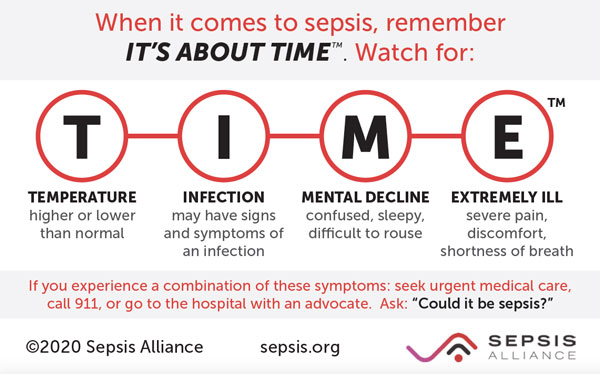What is sepsis?
Sepsis is the body’s overwhelming and life-threatening response to infection, which can lead to tissue damage, organ failure, and death.
Who can get sepsis?
While sepsis can impact anyone, including the sick, the well, and people of all ages, some groups are more likely to be affected. These include very young children, older adults, and those with a weakened immune system.
What are the symptoms of sepsis?
Sepsis Alliance designed an easy-to-remember tool for the signs and symptoms of sepsis. A person with sepsis could have one, all, or a combination of the below symptoms.

Why does TIME matter?
For every hour treatment is delayed, the risk of death increases by 4% - 9%. As many as 80% of sepsis deaths could be prevented with rapid diagnosis and treatment.
Key Sepsis Facts
Sepsis is a public health crisis. Help educate the people in your life on the devastating impact of sepsis using the facts below.
- More than 1.7 million people in the U.S. are diagnosed with sepsis each year.
- In the United States, sepsis takes a life every two minutes.
- 350,000 adults die from sepsis every year in the U.S. This is more than opioid overdoses, breast cancer, and prostate cancer combined.
- Sepsis is the leading cause of death in U.S. hospitals.
- More than 75,000 children develop severe sepsis each year in the U.S. and 6,800 of these children die, more than from pediatric cancers.
- Sepsis is the number one cause of hospital readmissions, costing more than $3.5 billion each year.
- Sepsis is the #1 cost of hospitalization in the U.S. Costs for acute sepsis hospitalization and skilled nursing are estimated to be $62 billion annually.
- Black individuals bear nearly twice the burden of sepsis deaths, relative to the size of the Black population, as compared to white individuals.
- Black women are 3.3 times more likely to die from pregnancy-related causes than white women in the U.S. Native American and Native Alaskan women are 2.5 times more likely to die than white women.
For more information on sepsis visit sepsis.org.
©2022 Sepsis Alliance







